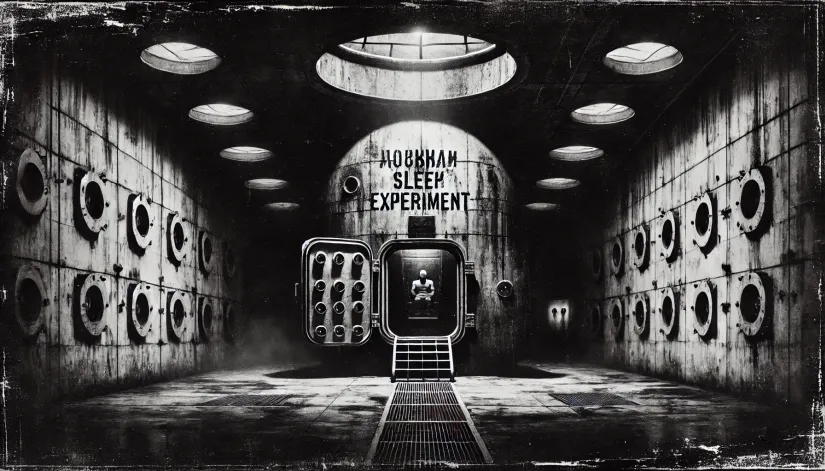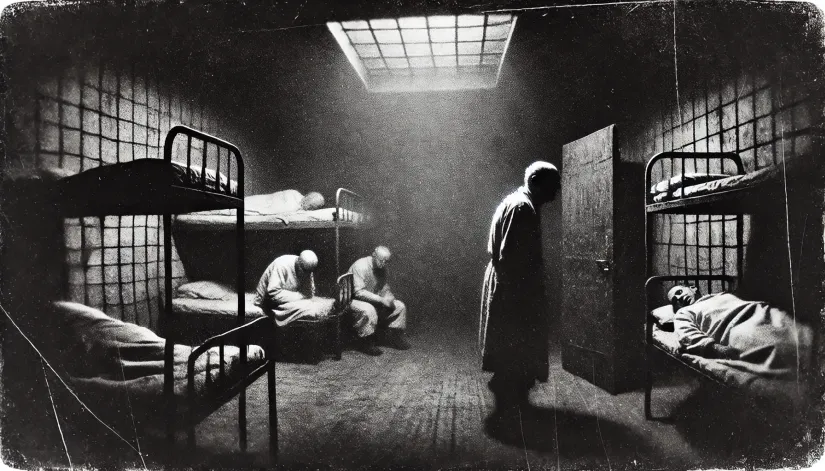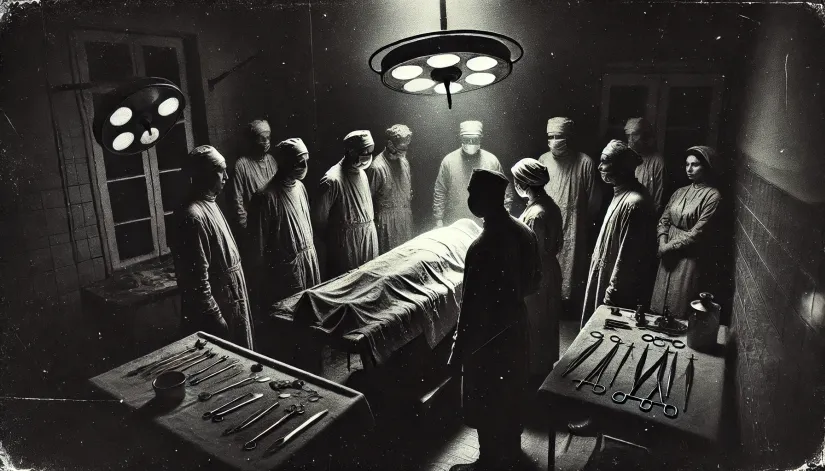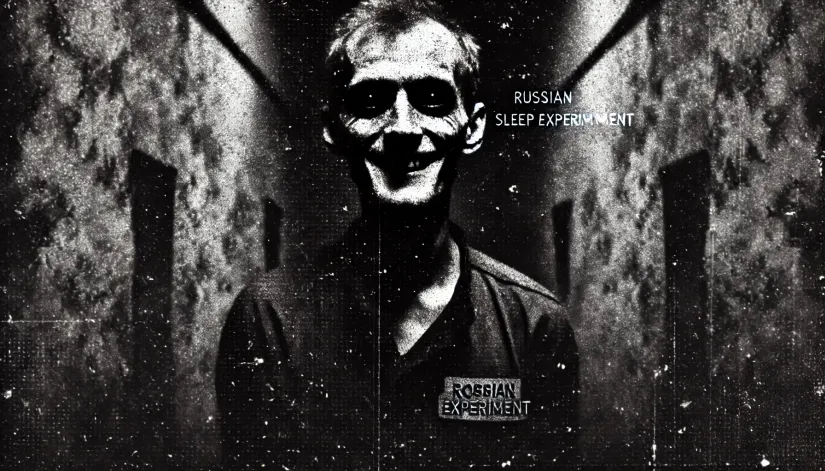Back in the late 1960s, the Russian Sleep Experiment became one of the most twisted and gruesome studies ever conducted on human subjects. Things got so messed up that the researchers themselves pulled the plug, and the whole project was buried under a pile of classified files.
But what exactly happened? And what convinced the Soviets to shut down the whole experiment?
In this article:
What Is the Russian Sleep Experiment?
According to declassified U.S. intelligence reports, in the 1960s and 1970s, deep within a secret lab somewhere in Siberia, the USSR conducted some downright terrifying experiments.
While most documents were heavily redacted—especially details about what went down with the test subjects—the leaked information was enough to spark several urban legends and horror stories about these bizarre trials.
Turns out, the Russian Sleep Experiment was just one piece of a more twisted puzzle—a series of messed-up tests on humans and animals alike.
According to these accounts, after World War II, the Soviets were knee-deep in grotesque experiments.
They tried everything—from concocting strange drug cocktails to pushing people to the brink with sleep deprivation, inducing near-death experiences, testing humans with supposed clairvoyant abilities, and even attempting to resurrect dead animals.
Believe it or not, there’s actual footage of some of these experiments—grainy black-and-white videos showing severed animal heads kept “alive” with bizarre contraptions and chemicals.
So, what’s the deal with the Russian Sleep Experiment? Here’s one of these horror stories versions:

Experiment Preparation
October 12, 1962—Deep within a secluded Soviet research facility in Siberia, a covert experiment was about to begin. The Cold War was at its peak, and the Soviet scientists were already looking to push the boundaries of human endurance.
The Russian Sleep Experiment’s objectives? To study the effects of extreme sleep deprivation combined with an experimental stimulant gas designed to keep subjects awake.
Five prisoners were selected for this harrowing trial. Each unaware of the true nature of their captivity. They were sealed in an airtight chamber—thick concrete walls, just a few porthole windows, and a sealed steel door that slammed shut behind them.
Related: Cold War Secrets: Was the Russian Sleep Experiment Real?
Some microphones and speakers were also installed inside. That was the only way of communication between the prisoners and the researchers.
The men received enough food for about four weeks, some cots with thin mattresses, drinking water, a basic toilet and shower setup, and a stack of books. Cozy, right?
The Terrifying Sleep Deprivation Experiment
Now, here’s the twist—the Soviet scientists also pumped an experimental stimulant gas into the chamber to keep them awake. No sleep was allowed. Not even a nap.
And everything that happened inside that room during the Russian Sleep Experiment was carefully documented:
Day 1: October 12, 1962
At first, the chamber seemed pretty chill. The room (measuring 20 by 20 feet) was furnished with basic amenities: five cots, a small library of books, and a single table with chairs.
The prisoners—Ivan Petrov, Elena Smirnova, Sergei Ivanov, Maria Kuznetsova, and Dmitri Volkov—spent their time chatting and reading. They shared stories about their lives before incarceration, finding solace in each other’s company.
Day 2: October 13, 1962
By the second day, the prisoners settled into a routine. Conversations flowed easily as they explored the limited library.
Ivan talked about his family farm, Elena recounted her time as a teacher, Sergei shared memories of his military service, Maria discussed her dreams of becoming an artist, and Dmitri opened up about his struggles with alcohol addiction.

Day 3: October 14, 1962
On the third day, their interactions became more personal. Discussions mainly focused on lost loves, cherished memories, and regrets. The prisoners seemed to find comfort in their shared experiences.
Day 4: October 15, 1962
On the fourth day, subtle changes started to emerge. The prisoners grew increasingly agitated. Ivan snapped at a minor disagreement over book choices, and Elena began pacing the room restlessly.
Reading sessions decreased as their focus shifted from literature to their growing discomfort. It became evident that the lack of sleep was taking its toll, making them feel jittery and on edge.
Day 5: October 16, 1962
By day five, tensions were palpable. Dmitri openly complained about the experiment, demanding answers from the unseen scientists. Sergei became withdrawn, avoiding eye contact and refusing to participate in group activities. Maria attempted to mediate conflicts, but her efforts were met with hostility.
The scientists decided it was time to pump more experimental gas into the room.
Day 6: October 17, 1962
On the sixth day, the atmosphere turned oppressive. The prisoners stopped interacting altogether, retreating to different parts of the room in isolation. Whispers and faint moans echoed through the chamber, captured by hidden microphones.
SpookySight recommends: Who Is Resurrection Mary, Chicago’s Most Haunting Ghost?
Elena became paranoid, convinced that Sergei was plotting against her. Ivan tried to communicate through written notes, but his messages became incoherent.
Dmitri attempted to bargain with the scientists, offering information about his roommates in exchange for freedom.
Day 7: October 18, 1962
Day seven was marked by even more erratic behavior. Sergei had sudden fits of crying and uncontrollable laughter. Maria started drawing disturbing images on the walls, her hands shaking uncontrollably.
Day 8: October 19, 1962
The scientists debated halting the experiment, recognizing the severe psychological impact. However, orders from higher authorities mandated the experiment to continue.
So, they decided to pump more experimental gas into the room.
Day 9: October 20, 1962
On the ninth day, Ivan reached his breaking point. He launched into a violent rage, screaming, running around the room, and slamming his head into walls with feral intensity.
Maria and Elena restrained him using torn strips from their bedsheets. By the time Ivan calmed down, his voice was unrecognizable. His screams turned into agonized squeaks.
Day 10: October 21, 1962
Day ten brought a new level of weirdness. Maria and Sergei started ripping pages from the books. They used their own feces to plaster them over the porthole windows and microphones.
The other three huddled in corners, muttering gibberish.
The researchers watched as the prisoners meticulously covered every porthole, working slowly, with eerie smiles. It was like they had a secret plan they didn’t want anyone else to know about.
More experimental gas was pumped into the room.
Day 11: October 22, 1962
By day eleven, they lost all visual contact—the portholes were all covered, and the chamber was sealed off from sight. Some microphones still picked up sounds. But it was mostly static and some occasional whispers and moans.
The scientists debated—again—about shutting down the experiment, since collecting data was next to impossible now.
But they pressed on.
Day 12: October 23, 1962
The twelfth day was eerily quiet, punctuated by disturbing noises captured by the microphones. Whispers filled with pleas for help and incoherent threats echoed through the chamber. Howls of anguish suggested that the prisoners were spiraling into complete madness.
The researchers struggled to interpret the sounds, fearing that the subjects were experiencing severe hallucinations from relentless sleep deprivation.
Day 13: October 24, 1962
The whispers became more coherent on the thirteenth day, though still fragmented. Maria’s previous drawings were now completely obscured by the paper coverings, hiding any trace of her deteriorating mental state.
Day 14: October 25, 1962
Another quiet day. The scientists tried to communicate with the subjects, but no response from the inside.
More experimental gas was pumped into the room.
Day 15: October 26, 1962
Total silence. The screams stopped, the whispers ceased. Nothing. The scientists kept checking the equipment, convinced the microphones must be busted. No way could five people be that quiet.
The Experiment Ends
With no data coming in, the researchers finally decided to pull the plug and open the chamber.
They flushed the chamber, replacing the gas with fresh air. However, as soon as the gas cleared, the microphones picked up multiple voices screaming and begging for the gas to be turned back on.
After another 30 minutes, the security team opened the door. The room was completely dark. An awful rotten smell came from the inside. One of the security men yelled: “Step away from the door and lie flat on the floor, or you’ll be shot. Comply, and you’ll be freed.”
SpookySight recommends:
- Japanese Horror Stories: The Red Room Curse (Akai Heya)
- Horror Stories: The Ghosts of Nam Koo Terrace
- The Rake Monster: Creepypasta’s Most Terrifying Urban Legend?
To their surprise, an answer was heard from inside: “We no longer want to be freed.”
Inside, only three of the five prisoners were still alive—if you could call it that. Some untouched food supplies were scattered all over the place.
Ivan and Dmitri were dead. Big chunks of their flesh were torn off and stuffed into the drain.
The other three surviving prisoners were mutilated. Deep wounds gaped on their bodies—skin flayed off hands and feet, fingers mangled down to the bone. Maria’s intestines were spilling out, yet she sat there, unfazed, chewing on what looked like raw human flesh.

Examining the Subjects
The security team, these soldiers, were battle-hardened vets, but nothing could’ve prepared them for this. Only a few dared to step inside to drag out the prisoners.
The subjects screamed and fought, begging to be put back under the gas. They attacked the soldiers viciously—one soldier bled out after a prisoner tore into his neck with his teeth.
Amid the chaos, Elena struggled so fiercely that she ruptured her own spleen and died on the spot.
A couple doctors tried sedating the other three subjects, pumping them full of tranquilizers—even triple doses—but nothing really worked.
Maria’s condition was also dire—her abdomen was torn open, organs exposed. She was rushed to the operating room, but they couldn’t sedate her. She kept fighting and screaming like a wild animal; it took four soldiers to hold her down. A few moments later, she was dead.
The autopsy was a shocker. Given the extent of her injuries—torn muscles, ruptured organs, broken bones—she should’ve been dead long before reaching the operating table.
Sergei wasn’t in a great spot, either. He couldn’t speak at all. His throat was infected and full of puss. The doctors agreed on surgery to remove the damaged tissue. However, since the anesthetic didn’t seem to work, they asked him if he’d agree to the procedure without it. He nodded in approval.
The operation took about one hour, and Sergei was awake the whole time. Strangely, he didn’t seem to be in pain. He was smiling. After the surgery, one of the surgeons handed him a notepad. He scribbled two words: “Keep cutting.”
Experiment Conclusions
October 27, 1962—Following the harrowing events of the fifteenth day, a high-ranking Soviet officer, Colonel Viktor Mikhailov, was summoned to oversee the experiment’s conclusion.
Colonel Mikhailov was well-known for his stern demeanor and unwavering commitment to Soviet research initiatives. His arrival signaled the final phase of the Russian Sleep Experiment.
However, handling the last surviving prisoner proved to be an excruciating task. The remaining subject, Sergei Ivanov, exhibited extreme physical and psychological deterioration.
Sergei was found in a state that surpassed typical sleep deprivation symptoms—his eyes were bloodshot and sunken, his skin pale and clammy, and his movements were erratic and jerky.
His once sharp features were now gaunt, with deep lines etched into his face from constant strain. His teeth were clenched tightly, and his nails were broken and torn from his fingers.
October 30, 1962—Colonel Mikhailov is accompanied by his security team. They wear some unfamiliar uniforms.
Colonel Mikhailov noted: “The subject’s condition is beyond any expectations we had. His physical state is irreparably damaged, and his mental faculties are non-functional. It is imperative that we terminate any further attempts to rehabilitate him. The risks to personnel are too great, and the potential for uncontrollable behavior remains high.”
Following Colonel Mikhailov’s orders, Sergei was transported to the medical bay for immediate euthanasia to prevent any further suffering or potential threat.
The procedure was swift, conducted with the utmost efficiency to minimize distress. However, the psychological toll on the medical staff was profound.
In compliance with directives to maintain secrecy, all records, footage, and physical evidence related to the terrifying Russian Sleep Experiment were meticulously destroyed. The facility was dismantled, and any remaining personnel involved were reassigned to other classified projects.







